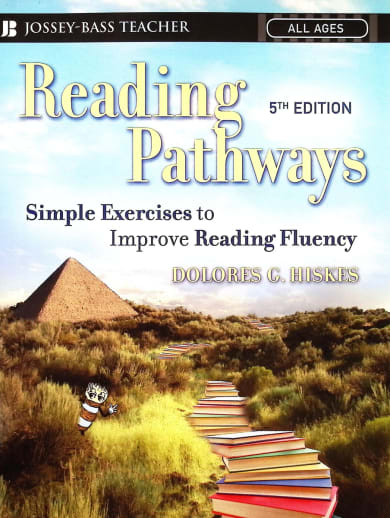Time for your "eyerobic" exercises! This phonics supplement from the author of Phonics Pathways is designed to strengthen eye tracking skills, a necessary component of fluent reading. Exercises are one of two types. The first type helps students sound out words one letter at a time, as successive letters are added. The name of the book comes from the second type of exercise, which is contained in a pyramid shape. At the top of the pyramid is one word. The next line contains the word in the first line, then adds another word. This pattern continues down the pyramid, with each line adding one or more words. The idea is to show that letters build into syllables, syllables build into words, words build into phrases, and phrases build into sentences. Students need to know their letters, consonant sounds, and short-vowel sounds to begin using the book. By the end of the book, students are reading multi-syllable, long-vowel words in sentences up to 20 words long.
Reading Pathways: Exercises to Improve Reading Fluency, 5th Edition
Description
Reading pyramids begins with one word, and slowly build into phrases and sentences of gradually increasing complexity. As the student moves from the pinnacle to the base of each pyramid, the phrase or sentence becomes a more interesting and expansive, and the student's confidence grows with each line completed. Progressively building up the amount of text per line increases eye span, strengthens eye tracking, and develops reading fluency. The book also features more challenging multi-syllable word pyramid exercises and games to further develop fluency and vocabulary. Learning to read long words by syllables removes the fear and mystique of multi-syllable words and helps students build the strong vocabulary so critical for success in reading and writing.
Well organized, systematic, incremental, and thorough in its presentation, Phonics Pathways offers clear instruction and lessons that require no preparation time. After reading through the brief introduction, you can sit right down with the book and your child, and in 10-15 minutes a day teach your child to read.
This book teaches phonograms, contractions, plural forms,
homonyms and homophones, homographs, prefixes, suffixes, and compound words. No
supplemental readers or materials are needed, so the program is a one-book
wonder. Pages are black and white, reproducible, and the font is larger for
easy reading. Games are incorporated throughout for reinforcement of the
concepts being learned. A short amount of instruction is included on the pages,
so parents should have no problem implementing the lessons. 10th edition.
The Reading Pathways phonics supplement from the author of Phonics Pathways is designed to strengthen eye tracking skills, a necessary component of fluent reading. Students need to know their letters, consonant sounds, and short-vowel sounds to begin using the book. By the end of the book, students are reading multi-syllable, long-vowel words in sentences up to 20 words long.
| Product Format: | Softcover Book |
|---|---|
| Grades: | PK-6 |
| Brand: | Jossey-Bass |
| Author: | Dolores G. Hiskes |
| ISBN: | 9780787992897 |
| Length in Inches: | 11 |
| Width in Inches: | 8.5 |
| Height in Inches: | 0.375 |
| Weight in Pounds: | 1.05 |
| Edition: | 5th Edition; Revised; Illustrated |
| Pages: | 135 |
| Publication Date: | 1/7/2013 |

